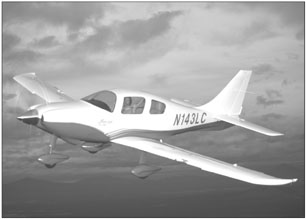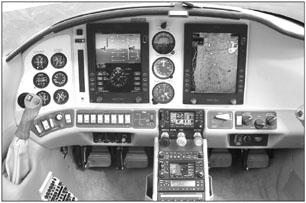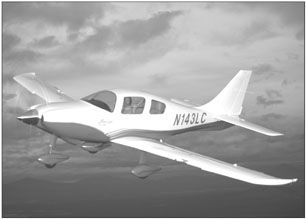
by Rick Durden
If speed is indeed life, Lancair Columbia 400 owners are living large.Well say it up front; our speed runs indicated to us that Lancairs eye-watering published cruise speeds for the airplane are accurate and possibly conservative. With that established, the question for our evaluation became whether the airplane is one-dimensional. In other words, must its speed buttress other shortcomings?
The answer is no. The 400 goes fast, handles well, is extraordinarily strong and looks good without shoehorning everyone into a tiny egg. Moreover, the 400 may be giving Lancair a needed boost to get its production numbers more in line with Cirrus, the current market leader in composite airplanes.
When we visited the factory to review the Columbia 300 a couple of years ago, the place had a hollow echo. With a recent influx of capital and a stack of orders, Lancair is going full blast and space is at a premium.
Part of the turnaround can be credited to the Columbia 400, first delivered in the spring of 2004, after completing certification under the horrendously expensive challenges of FAR 23. As of early this year, three airplanes per week were emerging from the factory, two which are Columbia 400s. Were told Lancair expects to reach one airplane a day by this summer.
Big Power
To suit its design brief as a flight-level flier, the Columbia 400 has a 310-HP, dual-turbocharger equipped Continental TSIO-550-C along with some accompanying airframe changes from the Columbia 350. Most noticeable are the vertical stabilizer and the rudder, which are larger and of a different shape. As with the earlier models, certified as spin resistant, the wing changes shape and chord at the two-thirds span point to improve aileron effectiveness at low speeds. However, because the 400 is certified as spin recoverable rather than spin resistant, stall strips have been added along the wing leading edge, along with a dorsal strake on the aft fuselage.
All flight controls are composite and are actuated by a combination of push rods and cables. Electric trim is provided for the elevators and ailerons through a coolie hat switch on the side stick and trim is annunciated via lights on the panel, with neutral being the takeoff setting.The ailerons have anti-servo tabs that, in our observation, eliminated any breakout force or dead areas in roll and, with the gearing selected for the system, generated appropriate feel and a more than adequate roll rate. Like the 300 and 350, the 400 was certificated in the Utility instead of the Normal category. So whats the big deal with that? The Utility category requires the airframe to withstand 4.4 G rather than the 3.8 G required in the Normal category. While that doesnt sound like much, certification rules require that the manufacturer demonstrate multiples of those G loadings when the airframe is bent and twisted during testing.
This kind of excess strength can sometimes come at the expense of excess weight, but it appears that Lancair has taken advantage of the brute strength of composites to keep the weight reasonable. Further, Lancairs structural certification testing was done at skin temperatures of 175 degrees F, high enough that the airframe is not limited to only white paint.
Were cynical enough to realize that despite it being built hell-for-stout, someone will probably break a Columbia 400 someday. But it will require an heroic screw-up, in our view. The wing is built up in one piece with dual spars and the fuel cells between the spars, providing additional crash protection. The fuel lines from the tanks run in front of the front spar for about 18 inches before entering the fuselage. Thats not the ideal location, but the area of exposure to crash impact is short.
We were told that part of the design philosophy was to make systems easily accessible for maintenance. Rather than have a massive number of inspection plates, getting at everything requires only removal of the cowling and two fuselage panels. Lancair claims that the basic annual inspection-not including repairs-can be performed by two people in 12 hours. Not having to rig and swing retractable gear suddenly seems sensible.
Systems, Cabin
The impressive speed of the Columbia 400 is the unsurprising result of a slick airframe and a large engine. The TSIO-550-C is rated for 310 continuous horsepower, so everything is pushed to the stop on takeoff and left there during the climb. Above 18,000 feet, the fuel pump must be turned to the low position for vapor suppression but otherwise, its a set and forget system.
The fuel system has an attractive, wood selector under the pilots right hand, on the armrest, and the system is equipped with a couple of safety features. Positions are left, right and off and the gauge has a green light that illuminates to indicate which tank is selected. If the selector is set outside a positive detent, no tank indicator light will illuminate but a fuel-valve annunciator light will come on, a nice feature.
The electrical system is energized by two 60-amp alternators operating through two independent buses that feed a central bus. Should one alternator fail, there’s no need to shut anything down; the remaining alternator will carry the load, including the recently introduced electrical prop anti-ice system.
The Columbia 400s glass cockpit uses the Avidyne Entegra system, which weve found easy to use. The cockpit screens-PFD on the left, MFD on the right-are oriented vertically, as in bizjets, rather than horizontally. We found the vertical format more appealing, particularly when looking along the route of flight for adverse weather. It also allowed the installation of the back-up AI, heading indicator and airspeed indicator in a stack to the right of the PFD.
The PFD energizes when the first of two battery switches is activated. That power up the ADAHRS to begin its three- to five-minute alignment process prior to engine start. Weve expressed concerns about voltage spikes when starting the engine with the avionics powered up, but this has proven to be a non-issue.
The airplane also has a navcomm bypass switch that powers up just the number 1 comm for picking up a clearance before starting the engine.
The cabin reflects an attempt to match the interior of a luxury vehicle. We applaud the concept of the side stick for crashworthiness and for opening up space on the panel. The wood-trimmed stick is the nicest weve seen and appears to be designed with more than just a nod to ergonomics. It doesnt have the primitive pistol-grip found in other airplanes which require extending the index finger in a sort of reverse tea-drinking-pinkie-in-the-air to avoid hitting the push-to-talk switch. The pilots seating position is excellent, except that the push-pull throttle, prop and mixture controls were situated too far forward for comfort. If the power controls were a few inches further aft, we think the pilot seating would be as good as the best of the side-stick airplanes weve flown, the Adam A500/700 series.
Surprising to us in an airplane this fast, the cabin is about six inches wider than a Bonanza and has generous front legroom. The Columbia 400 is the only airplane weve flown in which a very tall pilot will have to move the seat forward from its most aft position for flight. Headroom is better than a Bonanza, but it still lacks an inch or two of being what we would consider adequate for taller pilots when the effects of turbulence are considered. We knocked our headset off several times during normal movement in the cockpit.
The panel is we’ll laid out and we were pleased to see that there were no cutesy switches on the ceiling. Visibility is good in all directions except upward. Rear seat room is not adequate for anyone over about 5-feet 10 inches, in our estimation, due to a lack of headroom. We couldnt sit in it with the pilots seat full aft, as is possible in a Cirrus.
The restraint systems are three-point, which surprised us, as crash research data indicates that they are not as effective as four- or five-point systems. Were not in favor of gull-wing cabin doors when it comes to emergency egress. However, Lancair has placed a placard on the underside of the fuselage explaining to rescuers how to open the doors to extract occupants if the airplane is inverted; there’s also a sturdy hammer under the pilots seat to create an emergency exit.
The oxygen system is built in, with outlets on the ceiling. The tanks are in the right wing root. The system is annunciated as to appropriate altitudes for use of cannuli or masks. An air conditioning system is a recent addition and is expected to go into production 400s soon. The condenser is remarkably small and located in the baggage area.
We observed that the vents are set up to aggressively flood the cabin with cool air-particularly along the windows-and that the controls are dirt simple. Just turn it on and select the temperature desired. It doesnt have to be turned off for takeoff; it was designed to be another set and forget system, as it should be, in our opinion. In April, at the Sun n Fun show, Lancair announced that its aircraft will be equipped with digital climate control packages, similar to luxury cars. We were pleased to see that the baggage door has two locks. Having seen more than our share of weird accidents involving pilots reacting inappropriately to inadvertent baggage door openings, we like the redundancy.
The nose gear is free-swiveling, so steering is via differential braking, although we found the rudder to be so effective that we could steer it through wide radius turns without touching the brakes. The nose gear geometry is such that its possible to attach a tow bar and push the airplane backwards into a hangar without the wheel swinging from stop to stop, accompanied by lush profanity from the operator, as is the case with a Diamond Star or Grumman Tiger.

Flight Impressions
There’s nothing unusual about the run-up, save for more annunciation than most of us are used to. We liked the autopilot self-test function, which annunciated what it was doing while it did it. The brief test was so easy that its less likely to be skipped than is the case with other systems weve used.
A large number of emergency or abnormal items are annunciated on the panel which is set up so that when ready for takeoff, it should be dark. Nice design thinking. We did find that the some of the lights on the annunciator were difficult to read in bright sunlight. Circuit breakers are near the pilots left calf and are stacked like theatre seating and labeled to allow them to actually be seen and identified.
On takeoff, the rudder becomes effective immediately; the nosewheel is raised at 60 knots. Substantial, but not uncomfortable, right rudder is required on the takeoff roll as we’ll as throughout climb. Full throttle and max RPM are maintained during the climb. At 300 pounds below gross weight, we recorded a 2000 FPM climb at Vy in a steep, but acceptable deck angle.The maximum TIT we saw in the Vy climb to 16,500 feet was 1370 degrees F with a max CHT of 368 degrees F, suggesting that Lancair has set up adequate fuel flow and that the engine is appropriately baffled. It took 8:35 to get to 16,500 feet from an airport at an elevation of 825 feet. On a subsequent evaluation on a 1600-mile round trip, it took 34:31 to reach FL250 to keep CHTs below 380 degrees F.
Due to the altitude capabilities of the airplane, pilots will need to know the 400s numbers, which vary with altitude. For example, best angle of climb varies from 82 to 86 KIAS and the high-end limiting speeds, such as Vfe, Vne and Vno, change with altitude to the point that the max flap operating speeds decline so far that flap operation is prohibited above 14,000 feet. In its speed descriptions for the 400, Lancair replaced the old standby Va maneuvering speed with Vo, maximum structural operating speed.
At 16,500 feet, running rich of peak EGT, at 85 percent power (max recommended cruise), we recorded 222 knots TAS, considerably better than the book claim of 214 knots at gross weight. Fuel burn was 24.5 GPH, a half-gallon per hour better than book. At a more reasonable 75 to 100 degrees rich of peak-we were 50 degrees F rich at 85 percent-fuel flow would have been greater.
Leaning to 1650 degrees F, which Lancair recommends because of the fuel flow and cooling benefits, gave us a fuel burn of 19.2 GPH at 215 knots and cooled the CHTs by 30 degrees. The Avidyne PFD software displays percent power when rich of peak, but that data disappears when the mixture is pulled lean of peak, a small shortcoming in the software, especially when the benefits of lean-of-peak operation are now widely recognized. At gross weight, at FL250, we observed 226 KTAS at 30.1 inches MP and 2500 RPM.However, CHTs were at or above 400 degrees F (one was at 426) and trending upward even at 100 degrees rich of peak. Power was reduced slightly and lean of peak operation reduced the CHTs to a max of 380 degrees F, for a TAS of 210 knots on 14.6 GPH. Quite impressive.
We did our maneuvering flight evaluations in the teens, to see if we could find any unpleasant handling quirks. We saw none. Steep turns gave an indication of the effects of advanced aerodynamics on the airplane; during 45 and 60-degree banked turns, the airspeed diminished by fewer than 5 knots in 360 degrees of heading change.
Slow flight proved to be solid and responsive once we recognized just how little power was required due to the clean airframe. Stalls, even at high altitude, were prosaic but with a defined break. So long as the rudder was coordinated, the airplane could be held into a stall without any wing drop; however, if the rudder isn’t coordinated, the airplane will roll.
Control authority in all phases of flight, in all configurations, is positive, one benefit of a tough set of certification regulations. Control feel is nicely harmonized, if slightly heavy, in our view. Pitch forces are firm and linear and to onset any significant G load takes a hard pull.
The flaps are clutch protected, so if Joe Hamfist calls for flaps above the max speed, they simply wont extend. While the current FARs make it tough to have high flaps speeds, another benefit of Utility certification is that the Columbia 400s flap speeds are noticeably faster than its contemporaries, allowing approach flaps to be used when shooting an instrument approach while scooting into a terminal ahead of Boeings and Buses. Partial flaps are available at 127 knots, full flaps at 117 knots.
Flap actuation is quite slow, which may be why there was no noticeable pitch change during extension or retraction. That slow flap drive speed may protect pilots against themselves when they try to dump flaps at the wrong time. For those concerned about slam-dunk approaches, speed brakes are an option on the Columbia 400. They pop out of the wing in two seconds and cause no pitch change, but a bit of vibration.
Returning to the airport, we experimented with ILS approaches at 100 to 120 KIAS with approach flaps. Once configured for landing and approaching at 80 to 85 KIAS with full flaps, its again apparent how clean the airframe is; the normal descent angle requires little power. Striving for a power-off, full-stall landing resulted in controllable, minimum energy touchdowns. The pitch attitude was never high enough for the nose to block forward visibility. Braking and rollout handling were entirely conventional.
Conclusion
Lancair seems to have recognized that the Columbia 400 is one fast airplane thats going to be operated by amateur pilots who may not keep their skills as polished as one might hope. Accordingly, the systems have been made as simple and easy to operate as possible. Nevertheless, it is an airplane that can catch up with a jet in a terminal area, so careful training of the pilots will be essential if the company hopes to have an accident rate acceptable to insurers.
When we checked, we were told that the insurers are currently rating the Lancairs alongside the Cirrus and that at least one insurer is refusing to write smooth liability coverage. Although we saw nothing in the handling of the airplane that gave us pause, some owners expressed ire that insurers rated them for premimum prices.
We did note that there are a number of subtleties and airplane-specific knowledge areas that must be mastered, largely due to the 400s ability to fly into the flight levels. These range from limiting speeds at altitude to the use of the boost pump for fuel vapor suppression and limitations on throttle operation when high.
To us, that means aggressive initial and recurrent training for owners. If such training is absorbed by potential buyers, Lancair should have a strong seller in the 400. It goes like crazy, is one heck of a lot of fun to fly, seems to have no bad habits and is luxuriously comfortable. At a price of about $550,000 equipped, its cheaper than twins that arent as fast, although more expensive than offerings from Cirrus and Mooney.
If the perfect, personal airplane will go 1000 miles at 200 knots, carry four people and be able to fly in ice, the Columbia 400 comes as close as anything weve seen in an unpressurized piston single.
Contact – The Lancair Co., 541-318-1144, www.flycolumbia.com.
Also With This Article
“Checklist”
“Columbia 400 Compared”
“The IO-550s Efficiency Edge”
-Rick Durden is an Aviation Consumer contributing editor.





